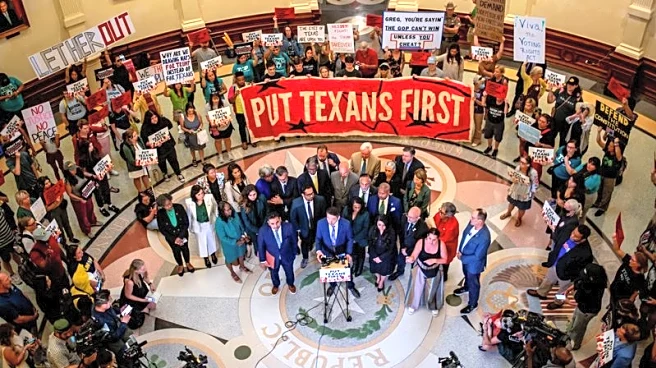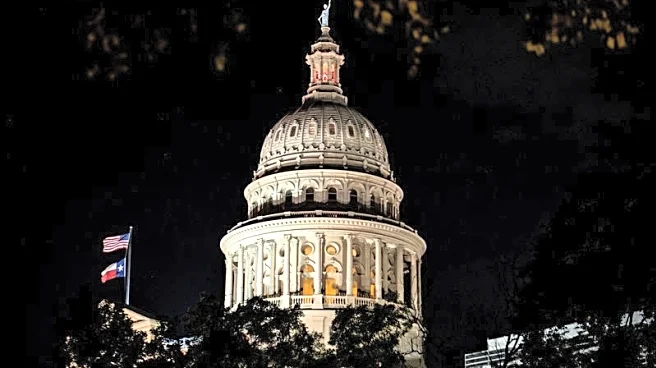By John Kruzel
WASHINGTON (Reuters) -Texas officials asked the U.S. Supreme Court on Friday to revive a voting map designed to boost the number of Republicans elected to the U.S. House of Representatives
from the state and help President Donald Trump's party keep control of Congress in next year's midterm elections.
State officials asked the justices to halt a lower court's ruling that blocked the map approved in August by the Texas legislature with Trump's support that redrew the boundaries of several U.S. House of Representatives districts in the state.
The lower court concluded that the map likely was racially discriminatory in violation of U.S. constitutional protections.
Republicans currently hold slim majorities in both chambers of Congress. Ceding control of either the House or Senate to the Democrats in the November 2026 elections would imperil Trump's legislative agenda and open the door to Democratic-led congressional investigations targeting the president.
The three-judge federal court's ruling in Texas dealt a blow to Trump's push for Republican-led state legislatures nationwide to redraw electoral maps to change the population composition of congressional districts - a process called redistricting - in order to boost the number of Republicans elected to the House.
The case involves an electoral map that the Republican-led Texas legislature passed and Republican Governor Greg Abbott signed into law that would likely flip as many as five currently Democratic-held U.S. House seats to Republicans in next year's elections.
The move by Texas to redraw its map prompted a nationwide battle over redistricting for partisan advantage that is playing out in both Republican-governed and Democratic-led states. For example, Democratic-governed California reworked the boundaries of its U.S. House districts to flip as many as five currently Republican-held seats to Democrats.
PARTISAN AND RACIAL GERRYMANDERING
There have been legal fights at the Supreme Court for decades over a practice called gerrymandering - the redrawing of electoral district boundaries to marginalize a certain set of voters and increase the influence of others.
The court issued its most important ruling to date on the matter in 2019, declaring that gerrymandering for partisan reasons - to boost the electoral chances of one's own party and weaken one's political opponent - cannot be challenged in federal courts. But gerrymandering driven primarily by race remains unlawful under the U.S. Constitution's 14th Amendment guarantee of equal protection under the law and 15th Amendment prohibition on racial discrimination in voting.
Many Texas Republican lawmakers have said the new map was devised in response to Trump's request to redraw electoral maps for a partisan advantage in House races. But the El Paso-based court ruled 2-1 on Tuesday that the map likely amounted to an unlawful racial gerrymander, siding with civil rights groups that sued to block it.
Each of the 50 U.S. states is represented in Congress by two U.S. senators, with representation in the 435-seat House based on population. California, the most-populous state, has the most House members with 52, while Texas is second with 38. Republicans currently hold 25 of 38 U.S. House seats in Texas.
'RACIAL CONSIDERATIONS'
U.S. District Judge Jeffrey Brown, who authored the Texas ruling, wrote that "what ultimately spurred" Texas to redraw its map was a letter from the U.S. Justice Department urging state officials to "inject racial considerations into what Texas insists was a race-blind process."
Brown, a Trump judicial appointee, wrote that the Justice Department's analysis was based on the "legally incorrect assertion" that the racial composition of four Texas congressional districts in the state's previous electoral map was unconstitutional and that they must be redrawn.
"Had the Trump administration sent Texas a letter urging the state to redraw its congressional map to improve the performance of Republican candidates, the plaintiff groups would then face a much greater burden to show that race - rather than partisanship - was the driving force behind the 2025 map," Brown wrote.
"But nothing in the DOJ (Department of Justice) letter is couched in terms of partisan politics," the judge wrote. "The letter instead commands Texas to change four districts for one reason and one reason alone: the racial demographics of the voters who live there."
The NAACP civil rights group noted in a statement after the ruling that "the state of Texas is only 40% white, but white voters control over 73% of the state's congressional seats."
The court directed that the state's previous electoral map, approved by the Republican-led legislature in 2021, be used in the 2026 elections.
The ruling marked the latest setback in Trump's push to tilt political maps. Indiana Republicans on November 14 abandoned a legislative session that had been called to enact a new congressional map in that state.
Democratic-governed California reacted to the Texas redistricting by initiating its own effort targeting five Republican-held districts in the state. California voters in November overwhelmingly approved a new map beneficial to Democrats. The Trump administration has sued California to try to stop its new congressional map from taking effect.
Virginia has advanced a plan to redraw its political maps, meaning Democrats could find themselves ahead in the redistricting fight should the Texas court decision hold.
Redistricting generally occurs to reflect population changes as measured by the national census conducted each decade, though this year's redistricting has been motivated by securing partisan advantage.
The Supreme Court, which has a 6-3 conservative majority, during its current term already has heard arguments in another major case involving race and redistricting. The conservative justices in a case involving a map of U.S. House districts in Louisiana signaled their willingness to undercut another key section of the Voting Rights Act, the landmark 1965 federal law enacted by Congress to prevent racial discrimination in voting.
(Reporting by John Kruzel; Additional reporting by Andrew Chung; Editing by Will Dunham and Amy Stevens)












